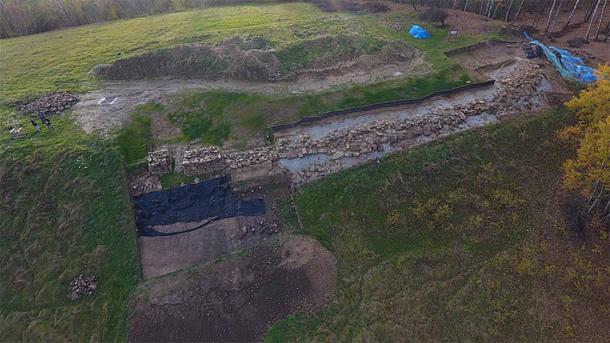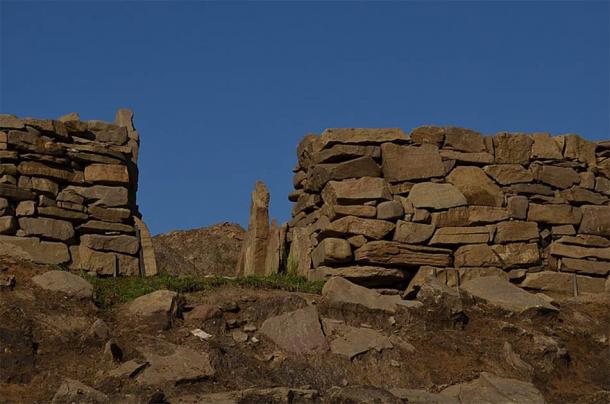Archaeologists working on a prehistoric settlement in Poland have discovered two tiny pig figurines, miraculously found intact after 3,500 years. The ancient relics can help experts to better understand prehistoric society in the middle of the second millennium BC, in this part of Europe.
The remarkable figures were found in Maszkowice (Małopolska) on a mountain known as “Zyndram’s Mountain” in the Carpathians in south-east Poland. It was found by archaeologists who were working on one “of the oldest examples of stone architecture in Europe and the oldest in Poland” reports Heritage Daily . The site was a hill fort, a fortified settlement. The discoveries were made as a team of experts were examining the monumental stone walls at Maszkowice.

Archaeologists working on “Zyndram’s Mountain” at Maszkowice, Poland ( CC by SA 4.0 / JJMaszko )
Bronze Age Culture
Heritage Daily reports that “Archaeological evidence suggests that the site was first occupied by the Ottomány, a bronze age culture”. They dominated much of Bronze Age Eastern Europe and the important trade route, which connected the Baltic Sea and the Mediterranean, and in particular, facilitated the trade in amber. This culture is famous for its massive stone structures.
The site was inhabited from about 1750 BC to 50 BC, but it was briefly deserted about 1500 BC when evidence of fires have been found, but the site was reoccupied and new and larger dwellings were built within the walls. It is possible that it was occupied by other societies after the collapse of Ottomány such as the La Tène.
The figurines were found in the remains of a hut, that was once about 20 (6m) feet long and wide and dates back 3,500 years. It is of a type known as a light braided structure. In a layer of clay in what was once the dwelling’s floor, the archaeologists unearthed the two tiny animal clay figures, which were instantly recognizable as representing pigs. They were found lying three feet (1 metre) apart.

Archaeological site at Maszkowice ( CC by SA 4.0 / Maszko78 )
Prehistoric Pig Figurines
Heritage Daily quotes Dr Marcin S. Przybyła of Jagiellonian University as stating that “These are the first such findings of zoomorphic figures that are representing animals”. The objects are only an inch or so in length, but they are very realistic. Despite their size, features such as their nipples and a snout can be made out. The sophistication of the objects shows that the inhabitants of the settlement were skilled craftsmen or traded with communities who had these specialists.
The next question was whether the pigs were domesticated animals or wild pigs. The figurines have clear marked ridges on their backs indicating that they were possibly wild. However, Dr Przybyła is quoted by Naukaw Polsce as saying that “It must be remembered that pigs were more like wild pigs than modern breeding pigs at the time”.
The figures are somewhat different in style and they may have been made by two different people. They were burned at some stage, possible when the hut went on fire.

Part of the wall of the hillfort at Maszkowice ( CC by SA 4.0 / Maszko78 )
Mystery of the Figures
“The answer to the question of what was the function of the figurines, according to the archaeologist is not easy” according to Nauwka Polsce. Traditionally, they would have been regarded as children’s toys or possibly religious objects. However, no-one is sure. What can be established is that the artifacts were found in a hut that had a great many animal bones including those from pigs. The tiny pigs and the bones show how important these animals were to the society that built the fortified settlement.
Restoration work is continuing at the site. The latest season has revealed more about this important site. Dr Marcin stated that “it can be seen that these fortifications were made in a very thoughtful way, and the builders had experience in similar projects” according to Nauwka Polsce. It is believed that this know-how was brought by immigrants from the Adriatic region or even further south. This and the finds of the figurines demonstrate the sophistication of the people who lived at the location 3,500 years ago.
Top image: Ancient pig figurines found in Polant Credit: PAP / Grzegorz Momot
By Ed Whelan
Related posts:
Views: 0
 RSS Feed
RSS Feed

















 August 17th, 2020
August 17th, 2020  Awake Goy
Awake Goy  Posted in
Posted in  Tags:
Tags: 
















